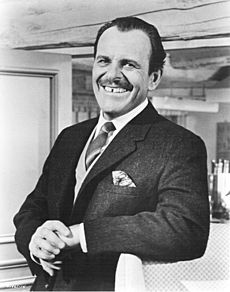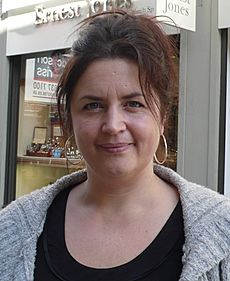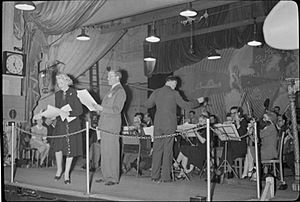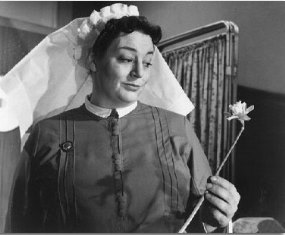Hattie Jacques facts for kids
Hattie Jacques (born Josephine Edwina Jaques; 7 February 1922 – 6 October 1980) was a famous English comedy actress. She was well-known for her roles on stage, radio, and in films. Many people remember her from the popular Carry On movies. In these films, she often played strict but funny characters, like a hospital matron.
Hattie Jacques also worked a lot in television and radio. She became famous through her appearances on three popular BBC radio shows: It's That Man Again, Educating Archie, and Hancock's Half Hour. After World War II, she started her film career. From 1958 to 1974, she was in 14 Carry On films. On television, she had a long partnership with Eric Sykes, starring together in his series Sykes. This role made her very popular with the public.
Hattie Jacques was married to actor John Le Mesurier from 1949 to 1965. She had health problems later in life and passed away from a heart attack on 6 October 1980, at the age of 58. People remember her for her "larger-than-life comedy" and her amazing talent.
Contents
Biography
Early life: 1922–1944
Hattie Jacques was born Josephine Edwina Jaques on 7 February 1922. Her birthplace was 125 Sandgate High Street, Sandgate, in Kent, England. Her father, Robin Rochester Jaques, was a serviceman in the British Army and later the Royal Air Force. Her mother, Mary Jaques, was a nurse.
Hattie's mother loved the theatre and took Hattie to see live shows from a young age. This had a big effect on young Hattie, who especially loved to dance. Her father, Robin, was a keen sportsman and played football semi-professionally. Sadly, he died in a flying accident on 8 August 1923.
After her father's death, Hattie, her mother, and her older brother Robin moved to London. Hattie went to Lady Margaret primary school in Chelsea. In July 1930, she started secondary school at the Godolphin and Latymer School in Hammersmith. She also attended a local dance school, where she was a main dancer in their shows. She left school in 1939.
When Second World War started, Hattie became a nurse. She worked in a mobile unit in London, helping at bombed sites during the Blitz. Later, in 1943, she worked as a welder in a factory. Around this time, she had a relationship with an American soldier.
Early post-war work: 1944–1950
In 1944, Hattie Jacques began her professional acting career. She performed at the Players' Theatre in London. She quickly became a regular performer there, appearing in music hall shows and playing the Fairy Queen in pantomimes. This theatre was like her acting school. She acted, directed, and wrote lyrics.
In June 1946, she made her television debut when a show from the Players' Theatre was broadcast on the BBC. She got her nickname "Hattie" in 1946. After performing in a show, someone compared her to the American actress Hattie McDaniel. Hattie liked the name and used it for the rest of her life.
Hattie Jacques first appeared in a film in 1946, called Green for Danger. Her role was small and not credited. In December that year, she joined the Young Vic Theatre Company. She performed in a play called The King Stag, which toured the UK. In March 1947, her first credited film role was released in Nicholas Nickleby.
While working at the Players' Theatre in June 1947, Hattie met actor John Le Mesurier. They started a relationship.
In August 1947, Hattie was invited to audition for the BBC radio show It's That Man Again (ITMA). She joined the cast as Sophie Tuckshop, a greedy schoolgirl. She would tell funny stories about eating lots of food, ending with her catchphrase, "But I'm all right now." She started on ITMA in September 1947 and was paid well for each episode.
Throughout 1948, Hattie continued to work on ITMA and perform at the Players' Theatre. She also appeared in the film Oliver Twist as a singer. She returned to the Players' for the Christmas pantomime, The Sleeping Beauty in the Wood. The Times newspaper said she was "among the funniest fairies" in her role.
The star of ITMA, Tommy Handley, died suddenly in January 1949. The show was cancelled because he was so important to it. Hattie later said he was "one of the greatest radio performers". Later that year, John Le Mesurier divorced his wife. Hattie then proposed to him, and they married on 10 November 1949. After a short honeymoon, she returned to the Players' Theatre for the Christmas pantomime.
Increasing fame: 1950–1958
In early 1950, the film Chance of a Lifetime was released. Hattie played Alice, a welder, and made a big impression. She even asked for more money for her work, saying she knew how hard welding was!
On 6 June 1950, Hattie was cast in the weekly radio show Educating Archie. She played Agatha Dinglebody. The show featured a ventriloquist's dummy named Archie Andrews. Hattie worked with Max Bygraves, Julie Andrews, and Tony Hancock on this show. She also first worked with Eric Sykes, who wrote scripts for the series. Eric Sykes was very impressed with Hattie's acting. He later wrote that she moved "with an elegance and grace". After the show, they met, and it was the start of a great professional friendship.
Throughout 1951, Hattie continued to work in different areas. She played Mrs Fezziwig in the film Scrooge. She also appeared in a second series of Educating Archie and a related stage show. She helped adapt and appeared in a Christmas pantomime at the Players' Theatre. In 1952, Hattie also played Mrs Jenks in the comedy horror film Mother Riley Meets the Vampire.

Hattie became pregnant in 1952 but continued to work. She appeared in a Players' revue, even doing the splits at the end! She also appeared in the third series of Educating Archie. In March 1953, Hattie gave birth to her first son, Robin. She returned to work quickly to film Up to His Neck. Later that year, she starred with John Le Mesurier in a short film called The Pleasure Garden. This film won an award at the 1954 Cannes Film Festival.
In 1954, Hattie continued her radio work. She was in Paradise Street and a special show called Archie in Goonland. She also appeared in Mrs Dale's Diary. She produced and directed a show called Twenty Minutes South. She also appeared in a TV series called The Granville Melodramas.
Hattie had her second son, Kim, in October 1956. In June 1956, she appeared in an episode of The Tony Hancock Show. This led to her role as Hancock's secretary, Griselda Pugh, in the BBC radio series Hancock's Half Hour. She appeared in many episodes alongside Hancock and other stars like Sidney James and Kenneth Williams. Her arrival on Hancock made the show even more popular.
In 1958, Hattie spent much of the year performing in a revue called Large as Life at the London Palladium. She performed alongside Terry-Thomas, Eric Sykes, and Harry Secombe.
The Carry On series: 1958–1963
Hattie Jacques joined the cast of the first Carry On film in 1958. These films became very famous for using the same group of actors, known as the "Carry On team". Hattie appeared in 14 of these films over 15 years. She often played a strict, no-nonsense matron in five of the films. These included Carry On Nurse, Carry On Doctor, and Carry On Matron.
The Carry On team saw Hattie as a "Mother Hen" figure. She was a close friend to many of her co-stars, like Kenneth Williams and Joan Sims. Joan Sims said Hattie was her "greatest friend" and like "both a sister and a mother". Hattie often invited her co-stars to her house for Christmas dinner.
Hattie's first Carry On film was Carry On Sergeant in March 1958. She played Captain Clark, a medical officer. The next year, she played "Matron" for the first time in Carry On Nurse. This film broke box office records, selling over 10 million tickets in British cinemas. She also played a maths teacher in Carry On Teacher (1959) and a friendly police sergeant in Carry On Constable (1960).
On 29 January 1960, Hattie appeared in the first episode of the BBC comedy series Sykes and a.... She co-starred with Eric Sykes as a pair of twins. Hattie's character, Hattie Sykes, was a dignified lady trying to keep her composure while the men acted foolishly. Sykes and a... ran for 60 episodes over nine series. It was a very successful British sitcom. Hattie and Eric Sykes became known as a wonderful comedy duo. They even released a comedy album together.
In September 1960, Hattie starred in another TV series, Our House. She played a librarian who was quiet at work but very noisy at home. Later that year, she had small roles in two films: Watch Your Stern and School for Scoundrels. Her screen time increased in Make Mine Mink, which she said was her favourite film.
In October 1961, Hattie appeared on the radio show Desert Island Discs. By this time, Carry On was a very popular film series. In 1961, Hattie had a small role in Carry On Regardless because she was not feeling well. In 1963, she appeared in her sixth Carry On film, Carry On Cabby. She played Peggy Hawkins, the wife of a taxi-firm boss. Hattie said this was her favourite Carry On film because she got to play a romantic lead instead of her usual "battleaxe" role.
Private challenges; new acting ventures: 1963–1967
Hattie Jacques faced personal challenges in 1963. She had met John Schofield, a used-car dealer, who gave her much attention. In 1964, John Le Mesurier moved out of their home. Hattie filed for divorce, and they separated.
In 1964, Hattie starred in her own television series, Miss Adventure, playing a private investigator. She wanted the series to be suspenseful, but it turned out to be more comedic. In August that year, she appeared in a TV production of Blithe Spirit. The play's writer, Noël Coward, praised her performance.
In 1966, Hattie went to Rome to film The Bobo with Peter Sellers. Before this, she went on a strict diet and lost a lot of weight. She enjoyed filming the movie. While she was in Italy, her relationship with John Schofield ended. Hattie was very upset, and her weight increased significantly.
Return to Carry On: 1967–1974
In the summer of 1967, the Carry On producer Peter Rogers brought the cast together for the film Carry On Doctor. Hattie was cast as the Matron, a role she had played before. Her part was made bigger in this film. Carry On Doctor was released in December that year and was very successful.
In 1968, Hattie appeared in 13 episodes of the sketch show The World of Beachcomber with Spike Milligan. She also appeared with Frankie Howerd in his sketch show. In 1969, she was busy with six films, including another with Peter Sellers, The Magic Christian. She also appeared in a TV musical called Pickwick and a Christmas TV special, Carry On Christmas.
In 1970, Hattie filmed Carry On Loving, playing Sophie Bliss. Another Carry On film followed in 1971, Carry On at Your Convenience. She also completed another series with Eric Sykes, Sykes and a Big, Big Show.
Two more Carry On films followed for Hattie in 1972: Carry On Matron, where she played the main role, and Carry On Abroad, as a fiery Spanish cook. Her screen time was reduced in Carry On Abroad. During the making of the film, the insurance companies became worried about Hattie's health.
In 1972, Hattie co-starred in the first series of Sykes. She played Hattie Sykes, Eric's kind and patient sister. At its peak, Sykes had 17 million viewers. In February 1972, Hattie watched her ex-husband, John Le Mesurier, win an award for "Best Television Actor". She was very emotional, feeling sad that she had lost him.
After Carry On: 1974–1980
Final appearances
In 1974, Hattie Jacques had a health scare while filming the third series of Sykes. She lost a lot of weight. She refused to stop filming. After filming finished, she had surgery for benign (non-cancerous) growths on her kidneys.
In 1976, Hattie appeared in a promotional film for British Rail. From 1976 onwards, Sykes and Jacques performed together in a stage play called A Hatful of Sykes. They toured the UK and other countries. During these tours, their relationship became difficult. Hattie's health also became problematic. She suffered from arthritis and leg ulcers.
Despite their differences, Hattie and Eric filmed the seventh series of Sykes in 1979. In April 1980, they filmed the TV movie Rhubarb Rhubarb. Hattie's part was small, and she looked a little unsteady.
Death and tributes

In May 1980, Hattie's doctor advised her not to travel to Greece. She visited Ireland instead. On the ferry back, she told a friend, "You know I'm not going to live long." Her health remained poor, and insurance companies would not insure her for film work. By October, her weight had increased again. She had trouble breathing and was admitted to Charing Cross Hospital.
She took a weekend break from the hospital and went home. On 6 October 1980, she passed away from a heart attack in her sleep at the age of 58. She also had kidney failure.
Hattie Jacques's funeral took place at Putney Vale Crematorium. Her sons did not allow Eric Sykes to attend the funeral because they were upset about how he had treated her during the stage show. Kenneth Williams, a close friend, was very sad about her death. John Le Mesurier described Hattie as "a remarkable lady" with "an aura of love and kindness". Her obituary in The Times said she would be remembered with affection. A memorial service was held for her at St Paul's, Covent Garden, known as the Actors' Church.
There is a memorial plaque for Hattie Jacques in St Paul's, Covent Garden. In November 1995, a blue plaque was placed at her former house in Earls Court, London. In 2002, plaques were unveiled for Hattie Jacques, Sid James, and Tony Hancock at BBC Broadcasting House in London.
In 2011, a BBC Four film called Hattie was made about Hattie Jacques's life. Actress Ruth Jones played Hattie Jacques. Hattie's son, Robin Le Mesurier, said Ruth Jones "had captured my mother perfectly." Ruth Jones was thrilled to play Hattie, calling her an "incredibly talented and fascinating woman."
Reputation
Writer Susan Leckey called Hattie Jacques "one of the best-loved British comedy stars." Her obituary in The Times said she was always successful at making people "laugh with, rather than at you." Peter Chapman of The Independent said Hattie was "blessed with remarkable grace, delicacy and warmth." Nina Wadia, a comedian, believes Hattie Jacques, along with Joan Sims and Barbara Windsor, helped open the way for younger female comedians in Britain today.
Hattie Jacques's biographer, Frances Gray, noted her talent for "larger-than-life comedy." She could also show "a broader comic mode" because of her amazing versatility. In her later career, especially in Sykes, she showed "a comic talent of extraordinary versatility." As a singer, she was also praised. Jonathan Cecil said her "bell-tone voice" had a hint of sadness, suggesting deeper talents. The actor Neville Phillips said she had a "pretty voice" and could give old songs new meaning.
Frances Gray points out that Hattie Jacques is always linked with the role of a hospital matron. Her portrayal of this character in five films had a lasting impact on how matrons are seen in the National Health Service (NHS). Some people even joked that NHS standards had slipped since "Hattie Jacques ran NHS wards." Nurses have sometimes complained about this stereotype, saying they are "not like Hattie Jacques anymore."
Alan Simpson, who co-wrote Hancock, enjoyed writing for Hattie. He felt she was "almost like a fella in terms of playing comedy." Neville Phillips thought she was "a complete revelation." He said that even though she was a large lady, her movements were "dainty, light and graceful." Her friend Bob Monkhouse believed her career was sometimes overshadowed by her size. He said, "She was such a great comedienne... everyone wanted her but the movers and shakers of entertainment didn't perceive her as anything other than a fat lady."
Garth Pearce wrote that Hattie "always chose to play women in funny situations, rather than refer directly to her weight." She focused on the script and her performance. However, some writers did focus on her size. Morwenna Banks and Amanda Swift felt Hattie was "unimaginatively cast as the 'fat person'" in ITMA. But in Sykes, her weight was rarely mentioned. Hattie herself said that Eric Sykes "hardly ever made jokes about my size which was a refreshing change." Gray believes that even when cast in broad comedy, Hattie "never played it broadly, but with an elegance of voice and body."
Credits
- Hattie Jacques on stage, radio, screen and record
See also
 In Spanish: Hattie Jacques para niños
In Spanish: Hattie Jacques para niños






